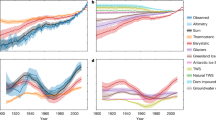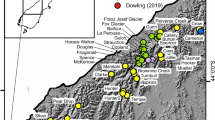Abstract
The mean sea level has been projected to rise in the 21st century as a result of global warming1. Such projections of sea level change depend on estimated future greenhouse emissions and on differing models, but model-average results from a mid-range scenario (A1B) suggests a 0.387-m rise by 2100 (refs 1, 2). The largest contributions to sea level rise are estimated to come from thermal expansion (0.288 m) and the melting of mountain glaciers and icecaps (0.106 m), with smaller inputs from Greenland (0.024 m) and Antarctica (- 0.074 m)1. Here we apply a melt model3 and a geometric volume model4 to our lower estimate of ice volume5,6,7 and assess the contribution of glaciers to sea level rise, excluding those in Greenland and Antarctica. We provide the first separate assessment of melt contributions from mountain glaciers and icecaps, as well as an improved treatment of volume shrinkage. We find that icecaps melt more slowly than mountain glaciers, whose area declines rapidly in the 21st century, making glaciers a limiting source for ice melt. Using two climate models, we project sea level rise due to melting of mountain glaciers and icecaps to be 0.046 and 0.051 m by 2100, about half that of previous projections1,8.
This is a preview of subscription content, access via your institution
Access options
Subscribe to this journal
Receive 51 print issues and online access
$199.00 per year
only $3.90 per issue
Buy this article
- Purchase on Springer Link
- Instant access to full article PDF
Prices may be subject to local taxes which are calculated during checkout




Similar content being viewed by others
References
Church, J. A. et al. in Climate Change 2001: The Scientific Basis (eds Houghton, J. T. et al.) 639–693 (Cambridge Univ. Press, Cambridge, UK, 2001)
Nakićenović, N. & Swart, R. (eds) Special Report on Emissions Scenarios 570 (Cambridge Univ. Press, Cambridge, UK, 2000)
Braithwaite, R. J., Zhang, Y. & Raper, S. C. B. Temperature sensitivity of the mass balance of mountain glaciers and icecaps as a climatological characteristic. Z. Gletscherkunde Glazialgeol. 38, 35–61 (2002)
Raper, S. C. B., Brown, O. & Braithwaite, R. J. A geometric glacier model for sea level change calculations. J. Glaciol. 46, 357–368 (2000)
Raper, S. C. B. & Braithwaite, R. J. The potential for sea level rise: New estimates from glacier and ice cap area and volume distributions. Geophys. Res. Lett. 32, L05502, doi:10.1029/2004GL021981 (2005)
Meier, F., Bahr, D. B., Dyurgerov, M. B. & Pfeffer, W. T. Comment on ‘The potential for sea level rise: New estimates from glacier and ice cap area and volume distributions’. Geophys. Res. Lett. 32, L17501, doi:10.1029/2005GL023319 (2005)
Raper, S. C. B. & Braithwaite, R. J. Reply to comment by M. F. Meier et al. on ‘The potential for sea level rise: New estimates from glacier and ice cap area and volume distributions’. Geophys. Res. Lett. 32, L17502, doi: 10.1029/2005GL023460 (2005).
Van de Wal, R. S. W. & Wild, M. Modelling the response of glaciers to climate change by applying the volume-area scaling in combination with a high resolution GCM. Clim. Dyn. 18, 359–366 (2001)
Oerlemans, J. in Ice in the Climate System (ed. Peltier, W. R.) 101–116 (Springer, Berlin/Heidelberg, 1993)
Cogley, J. G. GGHYDRO—Global Hydrographic Data Release 2.3, Trent Technical Note 2003–1 (Department of Geography, Trent Univ., Peterborough, Ontario, 2003); available at http://www.trentu.ca/geography/glaciology/glaciology.htm.
Kotlyakov, V. M. et al. World Atlas of Snow and Ice Resources 1–392 (Russian Academy of Sciences, Institute of Geography, Moscow, 1997)
National Snow and Ice Data Center (NSIDC). World Glacier Inventory http://www.nsidc.org/data/glacier_inventory/ (NSIDC, Boulder, Colorado, 1999)
Meier, M. F. & Bahr, D. B. in Glaciers, Ice Sheets and Volcanoes: A Tribute to Mark F. Meier (ed. Colbeck, S. C.) 89–94 (Cold Regions Research Engineering Laboratory Special Report 96–27, Hanover, New Hampshire, 1996); available at http://www.stormingmedia.us/24/2431/A243123.html.
New, M., Hulme, M. & Jones, P. J. Representing twentieth century space-time climate variability. 1. Development of a 1961–1990 mean monthly terrestrial climatology. J. Clim. 12, 829–856 (1999)
National Geodetic Survey data set. GLOBE. Available at the National Geophysical Data Center http://www.ngdc.noaa.gov/mgg/global/global.html (NGS, 1997).
Paterson, W. S. B. The Physics of Glaciers 480 (Pergamon, Oxford, 1994)
Dyurgerov, M. B. & Meier, M. F. Mass balance of mountain and subpolar glaciers: a new assessment for 1961–1990. Arct. Alp. Res. 29, 379–391 (1997)
Braithwaite, R. J. & Raper, S. C. B. Glaciers and their contribution to sea level change. Phys. Chem. Earth 27, 1445–1454 (2002)
Dyurgerov, M. B. & Meier, M. F. Twentieth century climate change: evidence from small glaciers. Proc. Natl Acad. Sci. USA 97, 1406–1411 (2000)
Arendt, A. A., Echelmeyer, K. A., Harrison, W. D., Lingle, C. S. & Valentine, V. B. Rapid wastage of Alaska glaciers and their contribution to rising sea level. Science 297, 382–386 (2002)
Rignot, E., Rivera, A. & Casassa, G. Contribution of the Patagonia Icefields of South America to sea level rise. Science 302, 434–437 (2003)
Meehl, G. A. et al. How much more global warming and sea level rise? Science 307, 1769–1772 (2005)
Geophysical Fluid Dynamics Laboratory. GFDL CM2 Modelhttp://data1.gfdl.noaa.gov/nomads/forms/deccen/ (GFDL, 2005).
Acknowledgements
Much of this work was supported by the HGF Strategiefonds Projekt (S.C.B.R.). We acknowledge the international modelling groups for providing their data for analysis, the Program for Climate Model Diagnosis and Intercomparison (PCMDI) for collecting and archiving the model data, the JSC/CLIVAR Working Group on Coupled Modelling (WGCM) and their Coupled Model Intercomparison Project (CMIP) and Climate Simulation Panel for organizing the model data analysis activity, and the IPCC WG1 TSU for technical support. The IPCC Data Archive at Lawrence Livermore National Laboratory is supported by the Office of Science, US Department of Energy.
Author information
Authors and Affiliations
Corresponding author
Ethics declarations
Competing interests
Reprints and permissions information is available at npg.nature.com/reprintsandpermissions. The authors declare no competing financial interests.
Supplementary information
Supplementary Table 1
Sensitivity analysis: parameter settings and experiment results exploring uncertainty. (DOC 31 kb)
Rights and permissions
About this article
Cite this article
Raper, S., Braithwaite, R. Low sea level rise projections from mountain glaciers and icecaps under global warming. Nature 439, 311–313 (2006). https://doi.org/10.1038/nature04448
Received:
Accepted:
Issue Date:
DOI: https://doi.org/10.1038/nature04448
This article is cited by
-
Flood prediction and vulnerability assessment at the south-western region of Bangladesh
Environmental Monitoring and Assessment (2023)
-
Historical glacier change on Svalbard predicts doubling of mass loss by 2100
Nature (2022)
-
Response of glaciers to future climate change in the Beida River catchment, northeast Tibetan Plateau
Journal of Mountain Science (2022)
-
Accelerated global glacier mass loss in the early twenty-first century
Nature (2021)
-
Trends in funding research and international collaboration on greenhouse gas emissions: a bibliometric approach
Environmental Science and Pollution Research (2021)
Comments
By submitting a comment you agree to abide by our Terms and Community Guidelines. If you find something abusive or that does not comply with our terms or guidelines please flag it as inappropriate.



